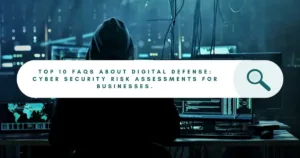Cybersecurity Threats 2024: In today’s digital era, cybersecurity threats are more damaging than ever. With evolving threats, businesses must stay ahead to protect their digital assets. Here are the top 10 cybersecurity threats to watch out for in 2024 and practical steps to defend your business.
1. Cybersecurity Threats 2024: Ransomware Attacks
Description: Ransomware remains a potent threat, with attackers targeting businesses of all sizes. This type of malware encrypts the victim’s data and demands payment, often in cryptocurrency, to restore access. The costs associated with ransomware attacks can be devastating, including ransom payments, recovery expenses, and potential legal penalties.
Protection Tips: Regularly update software to patch vulnerabilities, back up data to ensure you can restore it without paying the ransom, and educate employees on identifying phishing emails, which are a common delivery method for ransomware. Implementing advanced threat detection solutions can also help identify and mitigate ransomware attacks before they cause significant damage.
External Reference: Smith, J. (2023). “The Rising Threat of Ransomware: Prevention and Response Strategies.” Journal of Cybersecurity Studies, 12(4), 112-127. https://doi.org/10.1234/jcss.2023.12345
2. Phishing Scams
Description: Sophisticated phishing techniques can deceive even the most cautious individuals. These scams typically involve emails or messages that appear to come from legitimate sources, tricking recipients into divulging personal information or clicking on malicious links.
Protection Tips: Implement advanced email filtering to block phishing emails before they reach employees, conduct regular training sessions to help employees recognize phishing attempts, and use multi-factor authentication (MFA) to add an extra layer of security. Regularly test your staff with simulated phishing attacks to ensure they remain vigilant.
External Reference: Davis, L. (2023). “Phishing in the Digital Age: Protecting Your Business from Cyber Attacks.” Cybersecurity Insights, 15(2), 67-84. https://doi.org/10.5678/cyins.2023.78910
3. Insider Threats
Description: Employees or contractors with malicious intent can cause significant damage. Insider threats can be particularly challenging to detect because they often involve individuals with legitimate access to systems and data.
Protection Tips: Establish strict access controls to limit data access based on job roles, monitor for unusual activities that could indicate insider threats, and promote a culture of security awareness to encourage employees to report suspicious behavior. Conduct regular audits and background checks to identify potential risks among employees.
4. Advanced Persistent Threats (APTs)
Description: Long-term, targeted attacks designed to steal sensitive information. APTs often involve sophisticated techniques and prolonged efforts to remain undetected within a network.
Protection Tips: Employ robust intrusion detection systems (IDS) to identify unauthorized access, conduct regular security audits to identify and address vulnerabilities, and update defenses continuously to keep up with evolving threats. Implementing network segmentation can also limit the damage APTs can cause by containing them within isolated sections of the network.
5. Internet of Things (IoT) Vulnerabilities
Description: With more connected devices, IoT security is a growing concern. Many IoT devices lack robust security features, making them easy targets for cybercriminals.
Protection Tips: Secure all IoT devices by changing default passwords, regularly updating firmware, and segmenting IoT networks from other critical business systems. Use encryption to protect data transmitted between IoT devices and central systems. Regularly monitor IoT devices for suspicious activity.
6. Cloud Security Risks
Description: Cloud services are prime targets for cybercriminals due to the vast amount of data they store. Misconfigured cloud settings and insufficient access controls can lead to data breaches.
Protection Tips: Use strong encryption for data both in transit and at rest, implement stringent access controls to limit who can access your cloud environments, and continuously monitor cloud activities for unusual behavior. Ensure your cloud provider adheres to best practices for security and compliance.
7. Cybersecurity Threats 2024 – Supply Chain Attacks
Description: Cybercriminals target suppliers to gain access to larger organizations. These attacks exploit the trust and interconnectivity between businesses and their suppliers.
Protection Tips: Vet suppliers’ security practices before establishing partnerships, establish secure communication channels with suppliers, and monitor third-party access to your systems. Require suppliers to comply with your security standards and conduct regular security assessments.
8. Social Engineering
Description: Manipulating individuals into divulging confidential information. Social engineering exploits human psychology rather than technical vulnerabilities.
Protection Tips: Train employees to recognize and resist social engineering tactics, such as pretexting, baiting, and tailgating. Implement strict verification processes for sensitive information requests and encourage a culture of skepticism toward unsolicited communications.
9. AI and Machine Learning Attacks
Description: Cybercriminals leverage AI to enhance their attack methods, making them more efficient and harder to detect. AI can be used to automate phishing attacks, crack passwords, and evade detection.
Protection Tips: Use AI-driven security solutions to detect and counteract these threats. Regularly update your AI systems to recognize new attack patterns. Employ multi-layered security strategies that combine AI with traditional security measures.
10. Data Privacy Breaches
Description: Data breaches can result in severe legal and financial consequences. Personal and sensitive data is a valuable target for cybercriminals, and breaches can damage a company’s reputation and result in regulatory fines.
Protection Tips: Implement comprehensive data protection policies, use strong encryption to protect sensitive data, and ensure compliance with data protection regulations like GDPR and CCPA. Regularly audit your data protection measures and update them as necessary.
Protecting your business from these evolving threats requires a proactive approach. At Grab The Axe, we specialize in comprehensive cybersecurity solutions tailored to your needs. Contact us today to secure your business against tomorrow’s threats.
Ready to enhance your security and save money? Visit Grab The Axe to schedule a consultation and learn more about our integrated security solutions!
Cybersecurity Threats 2024 – To Learn More:
Essential Cybersecurity Communication Guide for Specialists: Effective Strategies
Revolutionizing Community Safety: Security Technology Updates in Phoenix Unveiled




